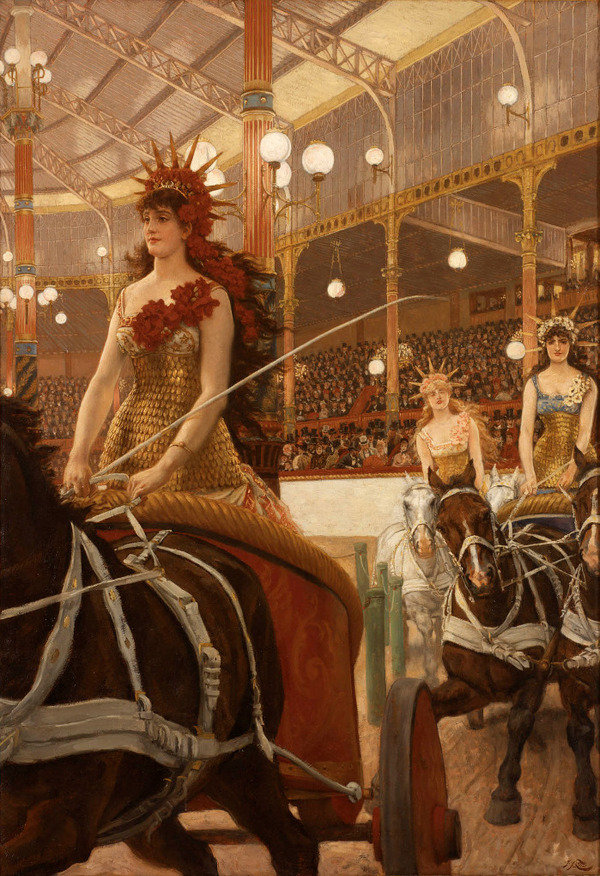Circus
dal 31/7/2014 al 21/2/2015
Segnalato da
31/7/2014
Circus
RISD Museum of Art, Providence
The spectacle of the American and European circus takes center stage in this glimpse into the visual world of this phenomenon during the height of its popularity, 1850 to 1960. About 40 paintings, drawings, prints, photographs, and posters by artists such as Alexander Calder, Marc Chagall, Henri Matisse...

The circus presents human and animal bodies in their extremes, juxtaposing grace, strength, and
elegance with the wonderous and grotesque. These characteristics extend to the visual culture of the circus, from ephemeral
advertisements designed by now-unknown artists to monumental canvases executed by critically acclaimed painters.
The artists whose works are featured in this exhibition delve into both the imagery of the circus and its wider cultural
connections, exploring popular entertainment as subject matter and a times using it as a tool for cultural critique.
The first modern circus was performed in London in 1768 at Philip Astley’s equestrian school, with the first American
incarnation debuting in 1774 in Newport, Rhode Island, with Christopher H. Gardner’s performance of equestrian acts.
Between 1850 and 1950, the circus grew to include animal
acts, acrobats, and the sideshow, giving rise in the U.S. to
Barnum & Bailey’s “Greatest Show on Earth” and the Ringling Brothers Circus, Zirkus Sarrasani and Zirkus Hagenbeck in
Germany, the Cirque Fernando (later Medrano) and the Cirque d’Hiver in Paris,
and dozens of smaller troupes
throughout Europe and the United States.
The spectacle of the Am
erican and European circus takes center stage
in this
glimp
se into
the visual world of this
phenomenon during the height of its popularity, 1850 to 1960.
About
40 paintings, drawings, prints, photographs, and posters by artists such as Alexander Calder,
Ma
r
c Chagall, Henri Matisse, James
-
Jacques
-
Joseph Tissot, and Henri de Toulouse
-
Lautrec
delve into life under the big top and its wider connections to culture and society.
The rise of the circus was closely tied to the industrialization of the United States and Europe. An increasingly pervasive
railroad system enabled touring to small towns as well as large urban centers. The manufacture of circus posters—typically made with woodcut until the 1870s—changed dramatically as widespread use of the technology of lithography
enabled poster designers to make more complex and graphically dynamic images in greater quantities. For its
audiences, the circus served as both entertainment and education, providing many circus-goers with their first exposure
to cultures from around the world, shaping knowledge while simultaneously reinforcing Western rule of, and cultural
dominance over, colonized lands.
Circus is made possible by the generous support of the Andrew W. Mellon Foundation and the Harlan & Amy Korenvaes Family Foundation
Image: James Tissot, Ladies of the Chariots, ca. 1883-1885. Gift of Mr. Walter Lowry.
Press contact:
Lani Stack
Senior Publicist 401 454 6506 lstack@risd.edu
Matthew Berry
Marketing Assistant mberry@risd.edu 401 709 8513
Design the Night celebration: August 21, 5-9 pm, FREE!
RISD Museum
20 North Main St (also enter on 224 Benefit Street) Providence, RI 02903
Hours:
Tuesdays through Sundays, 10 am–5 pm
Thursdays, 10 am–9 pm
closed Mondays, and January 1, July 4, Thanksgiving Day, and December 25.
Admission
Members: free
Adults: $12
Senior citizens (age 62+): $10
Youths (ages 5–18): $3
Children under 5: free
College students with valid ID: $5



